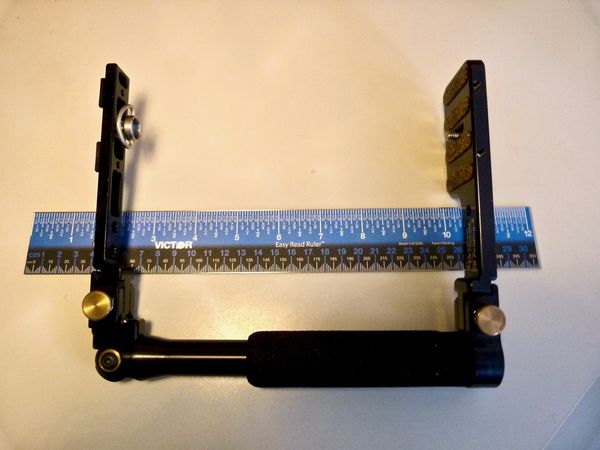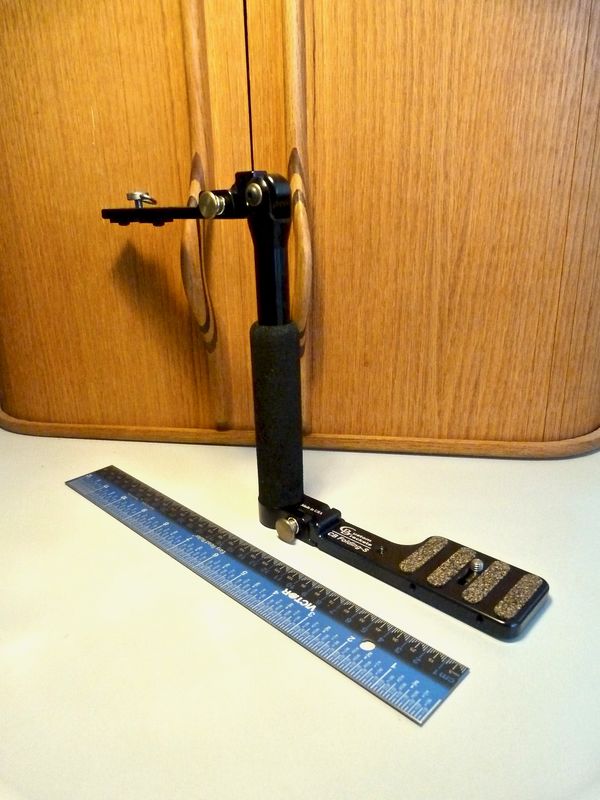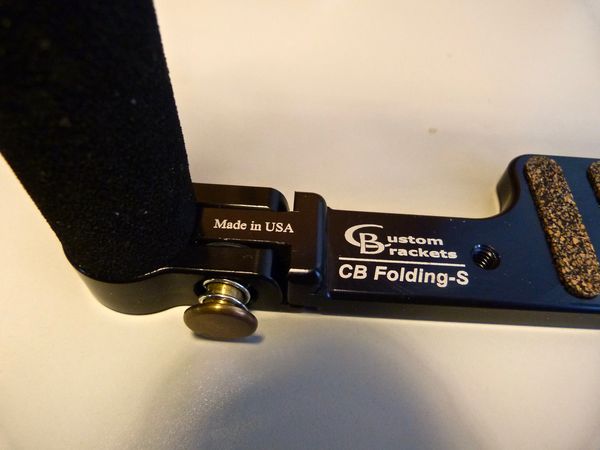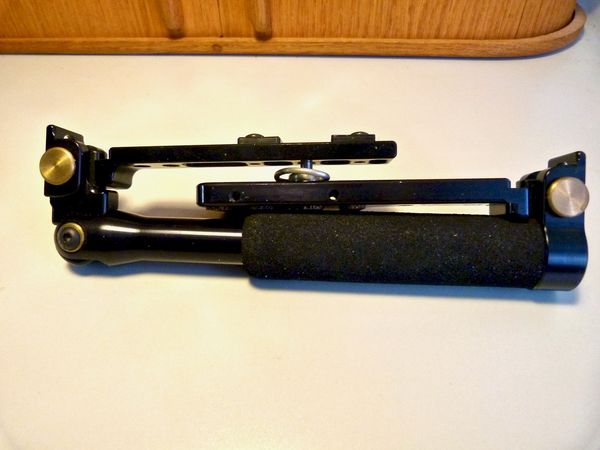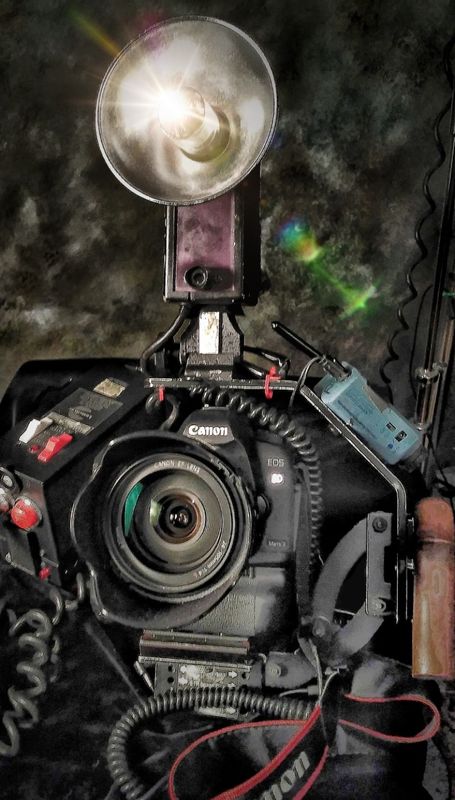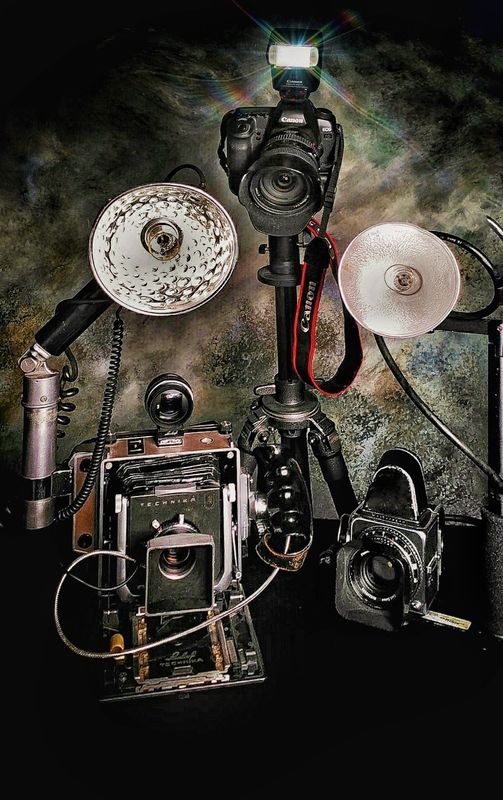Flash Brackets
Oct 29, 2018 07:01:08 #
Gene51 wrote:
Bounce, no Fong (only amateurs use them), hot shoe mounted flash, be happy. On camera flash is not a problem if you use it correctly.
See below. Flash on hotshoe, bounced over right shoulder off ceiling and nearby wall.
See below. Flash on hotshoe, bounced over right shoulder off ceiling and nearby wall.
Only amateurs?
My neighbor has a large thriving photography business for close to 40 years and does quite well with a hobby ranch and horses for fun uses the Fong product you condemn.
Oct 29, 2018 07:29:09 #
Architect1776 wrote:
Only amateurs?
My neighbor has a large thriving photography business for close to 40 years and does quite well with a hobby ranch and horses for fun uses the Fong product you condemn.
My neighbor has a large thriving photography business for close to 40 years and does quite well with a hobby ranch and horses for fun uses the Fong product you condemn.
I am not the only one that doesn't buy into the marketing -
https://neilvn.com/tangents/review-best-light-modifiers-for-on-camera-flash/
The basic concept is simple - the larger the light source the softer the light. A Fong thing will do two things - become an omnidirectional light and reduce your flash output by at least 66%, which will require longer recycle times and more frequent battery changes.
In a small room with a low ceiling and at relatively short distances, they "can" provide some slight benefit. In a large room and at greater distances it becomes a small source, and the quality of the light becomes harsh and contrasty. But by and large, this class of modifier is a complete waste of money. If you like the "look" of a Fong-lit image - edgy, contrasty, deep dark shadows - then save your $$$ and just hold on to your Chinese soup takeout containers - they will give you the same results.
Compared to an unmodified speedlight pointed directly at a subject, I suppose a Fong is better - but it is far from ideal.
I too have a friend who is a "professional" wedding photographer, and his results reflect everything I have said, and what was illustrated in Neil van Niekirk's blog post. The best results are achieved with bounce - like the image I posted above.
https://improvephotography.com/2545/gary-fong-lightsphere-collapsible-review/
Have you ever tried one yourself?
Oct 29, 2018 07:46:29 #
A flash bracket is absolutely necessary for event photography because it eliminates red eye and that pesky shadow of your subjects on the wall behind them. I use a Stroboframe that flips to keep the lens on axis about 8 inches above the lens in landscape or portrait . The height is readily adjustable too.
Oct 29, 2018 08:45:16 #
nimbushopper wrote:
A flash bracket is absolutely necessary for event photography because it eliminates red eye and that pesky shadow of your subjects on the wall behind them. I use a Stroboframe that flips to keep the lens on axis about 8 inches above the lens in landscape or portrait . The height is readily adjustable too.


 Being a tinkerer I have built my own similar to Stroboframe that moves the flash about 8" above & 8" to my left. It works quite well although a bit bulky, the left hand grips the upright and the load is acceptably balanced. An 8"x10" bounce card on the head gives nice softening but adds to the unwieldy bulk a bit. I haven't been able to cut down on the awkwardness so i just get-er-done and bear it.
Being a tinkerer I have built my own similar to Stroboframe that moves the flash about 8" above & 8" to my left. It works quite well although a bit bulky, the left hand grips the upright and the load is acceptably balanced. An 8"x10" bounce card on the head gives nice softening but adds to the unwieldy bulk a bit. I haven't been able to cut down on the awkwardness so i just get-er-done and bear it.Oct 29, 2018 09:09:02 #
Gene51 wrote:
I am not the only one that doesn't buy into the ma... (show quote)
Gene, I've more than once offered the same link from Neil and I tend to agree that many of the modifiers are purely marketing. When I first started lighting I bought Fong's Lightsphere. It's collected dust for several years now. Zack Arias for a long time used the Lightsphere as a grid holder. He cut the top off the Lightsphere and bungi corded a grid to it painting the base opaque black. He said it was better served that way than originally intended :)
Oct 29, 2018 09:11:35 #
Don, the 2nd son wrote:
img src="https://static.uglyhedgehog.com/images/s... (show quote)
Yes, but if it's 8" left it will still cast a shadow!
Oct 29, 2018 09:26:33 #
Dump the flash bracket and the useless Fong diffuser. Go with the adjustable “Flip-It” unit. Better results, much less hassle. It is hinged. You can bounce off walls, ceilings the unit itself with no hassle. It is all I use now. It’s works very well, and no need to constantly remove and re-attach it.
Demb Flash Diffuser Pro - Articulating Panel, 4.5" X 5" Plus Tiltable Front Diffuser. Controls Proportion Between Ceiling Bounce and Reflector Bounce. https://www.amazon.com/dp/B0089NBPB8/ref=cm_sw_r_cp_api_XLW1Bb6NQ6XV2
Demb Flash Diffuser Pro - Articulating Panel, 4.5" X 5" Plus Tiltable Front Diffuser. Controls Proportion Between Ceiling Bounce and Reflector Bounce. https://www.amazon.com/dp/B0089NBPB8/ref=cm_sw_r_cp_api_XLW1Bb6NQ6XV2
Oct 29, 2018 09:47:25 #
I have used a Stoboframe Press-T bracket when doing that sort of photography. It’s small enough and allows for vertical and horizontal orientation. But I also subscribe to the angle and bounce techniques of Mr. Niekerk.
Oct 29, 2018 10:22:40 #
I also have a "Custom Bracket" model Digital Pro-M and love it. The main advantages are that it puts the center of the flash ( if pointing forward) 10 inches above the center of the lens. That seems to take care of any red eye problem. It also, most importantly, lets you turn the camera from landscape to portrait and back without the flash moving from its position. I wish it was lighter but the weight is worth it for the advantages it has.
Oct 29, 2018 10:24:09 #
bpulv
Loc: Buena Park, CA
dandev wrote:
I do a lot of event photography where I walk the c... (show quote)
In the old days when early portable electronic flash units like the Graphix Strobflash were connected to a heavy battery pack slung over your shoulder and connected to the flash head via a coiled electrical cord were the norm, everyone use to hold the camera in one hand and the flash head in the other for off camera shots. We did this with heavy 4 X 5 press cameras all the time. Between shots, the D-cell battery cases (made for flash bulbs), on which the flash head was mounted, was clipped to the flash gun mount on the side of the camera. The D-cell battery case had a button switch on it that was connected to a solenoid mounted above or to the side of the lens and shutter on the camera's lens board. Pressing the button with a finger while holding the flash away from the camera above your head at an angle tripped the shutter while you held the camera with your other hand using the strap/handle over the back of your hand.
If you can hand hold a 4 X 5 and an off camera flash and take pictures at the same time, you can do the same thing with a relatively lightweight full frame DSLR and a modern portable electronic flash.
Oct 29, 2018 11:07:21 #
I too like the Custom Brackets especially the way they fold up so compactly to fit in a system case or on the outside tripod straps. (see pics)
02Nomad wrote:
If you are going with a flash bracket, I have had the best results and the least trouble with a Custom Bracket. They're not inexpensive, but they are worth every penny.
Oct 29, 2018 11:39:10 #
Harry0
Loc: Gardena, Cal
Old school foole here.
For decades I carried "modifiers" made from translucent plastic cartons.
A ping pong paddle shaped piece of milk jug will allow diffused light thru it.
And direct light above it. Or vice versa. Different sizes and shapes.
Elastic bands allow easy applications and changes. They pack well.
You can make them easily with a ruler and an exacto. Done well = look pro.
You can drill holes for more light. Paint spots for less. Be creative.
For decades I carried "modifiers" made from translucent plastic cartons.
A ping pong paddle shaped piece of milk jug will allow diffused light thru it.
And direct light above it. Or vice versa. Different sizes and shapes.
Elastic bands allow easy applications and changes. They pack well.
You can make them easily with a ruler and an exacto. Done well = look pro.
You can drill holes for more light. Paint spots for less. Be creative.
Oct 29, 2018 11:43:36 #
By using a “Flip-It” I have completely eliminated the need for a bracket of any kind.
Demb Flash Diffuser Pro - Articulating Panel, 4.5" X 5" Plus Tiltable Front Diffuser. Controls Proportion Between Ceiling Bounce and Reflector Bounce. https://www.amazon.com/dp/B0089NBPB8/ref=cm_sw_r_cp_api_XLW1Bb6NQ6XV2
Demb Flash Diffuser Pro - Articulating Panel, 4.5" X 5" Plus Tiltable Front Diffuser. Controls Proportion Between Ceiling Bounce and Reflector Bounce. https://www.amazon.com/dp/B0089NBPB8/ref=cm_sw_r_cp_api_XLW1Bb6NQ6XV2
Oct 29, 2018 12:25:49 #
Firstly, lets discuss the logic behind most of the (flash high over the lens) brackets. They were originally designed to preclude or somewhat improve the aesthetic disadvantages of on-the-camer flash usage. A direct flash unit either mourned directly on the hot shoe atop the camera or secured on a L-bracket beside the camera has a number of drawbacks. The light is relatively flat, there is little of no modeling or dimensionality and there is no depth of lighting which causes overexposed foregrounds and dark underexposed backgrounds- the inverse square law is working against you! Oftentimes, a distracting shadow on background walls would occur with the beside the camera mounts.
Early on, even in the days of the 4x5 press camera, with the advent of the quick release flash bracket and coiled synchronization cords, photographers managed to hold the flash unit higher above the camera and/or slightly off axis and create a little more modeling and a marginal degree of depth of illumination. This was a bit of a juggling act and a difficult physical feat what with a heavy camera in one hand and a rather large flash unit in the other, but they managed. Back in the day, the flash guns (used with disposable flash bulbs) and earlier portable strobes hand much larger lamp heads with much wider angles of coverage as compare to today's speedlights so the possibility of uneven lighting coverage was less prevalent. In the early 1960s the so called shadow-less bracket began to apear on the scene. Their basic concept was to elevate the lamp head about 12 inches directly above the lens. This minimized the background shadows and created a bit more modeling based on its vertical height. The lighting is still comparatively flat but is it even and the bracket enables more ease of handling. With square medium format cameras, a simple one position bracket would suffice, however, with rectangular format cameras there has to be a means of keeping the flash unit in place for both vertical and horizontal orientations. Some brackets have two quick release shoes for re-positioning and others have a swinging mechanism.
For event photography you want to select a bracket that is sturdy and will withstand hard and fast usage with a comparatively heavy camera and flash load, especially where larger modifiers are in use. You need to be able to quickly switch from horizontal to vertical orientations smoothly and rapidly and enable bounce or partial bounce modes when required. Other important considerations are ergonomic handling, a good center of gravity and balance and sturdy and positively locking hardware- you don't want things shaking loose in the midst of shooting.
I will attach a few images of the bracket setups I have used in the past and the ones I am currently using. I MADE my first bracket it 1960- I still have it! Some of the brands that are currently in manufacture are Stroboframe, ProMedia, DMKFoto and Sunway. On the used market you may find a Jones bracket.
So...unfortunately, with flash brackets you can't have your cake and eat it too. The lighting is still flat unless you move the main light source more off axis. In my own case, my on-camera light is always used in conjunction with other off-camera lights. At events,at least, I use. at least, one second ligh is manned by an assistant or placed in various static positions around the venue and triggered by radio slave systems. The over-the lens position works well with direct flash, modified flash, bare bulb, ceiling and wall bounce and for flash fill in daylight or existing light environments. 12 inches above the lens is a good height- some brackets may be adjustable.
If you are using a conventional speedlight with TTL operation, you will need a cable to connect between the hot shoe and the ligh atop the bracket to control exposure and enable synchronization.
As I have done, you may want to combine the advantages of more that one bracket in one rig by integrating a platform with another positioning mechanism or adding a more hefty grip.
Early on, even in the days of the 4x5 press camera, with the advent of the quick release flash bracket and coiled synchronization cords, photographers managed to hold the flash unit higher above the camera and/or slightly off axis and create a little more modeling and a marginal degree of depth of illumination. This was a bit of a juggling act and a difficult physical feat what with a heavy camera in one hand and a rather large flash unit in the other, but they managed. Back in the day, the flash guns (used with disposable flash bulbs) and earlier portable strobes hand much larger lamp heads with much wider angles of coverage as compare to today's speedlights so the possibility of uneven lighting coverage was less prevalent. In the early 1960s the so called shadow-less bracket began to apear on the scene. Their basic concept was to elevate the lamp head about 12 inches directly above the lens. This minimized the background shadows and created a bit more modeling based on its vertical height. The lighting is still comparatively flat but is it even and the bracket enables more ease of handling. With square medium format cameras, a simple one position bracket would suffice, however, with rectangular format cameras there has to be a means of keeping the flash unit in place for both vertical and horizontal orientations. Some brackets have two quick release shoes for re-positioning and others have a swinging mechanism.
For event photography you want to select a bracket that is sturdy and will withstand hard and fast usage with a comparatively heavy camera and flash load, especially where larger modifiers are in use. You need to be able to quickly switch from horizontal to vertical orientations smoothly and rapidly and enable bounce or partial bounce modes when required. Other important considerations are ergonomic handling, a good center of gravity and balance and sturdy and positively locking hardware- you don't want things shaking loose in the midst of shooting.
I will attach a few images of the bracket setups I have used in the past and the ones I am currently using. I MADE my first bracket it 1960- I still have it! Some of the brands that are currently in manufacture are Stroboframe, ProMedia, DMKFoto and Sunway. On the used market you may find a Jones bracket.
So...unfortunately, with flash brackets you can't have your cake and eat it too. The lighting is still flat unless you move the main light source more off axis. In my own case, my on-camera light is always used in conjunction with other off-camera lights. At events,at least, I use. at least, one second ligh is manned by an assistant or placed in various static positions around the venue and triggered by radio slave systems. The over-the lens position works well with direct flash, modified flash, bare bulb, ceiling and wall bounce and for flash fill in daylight or existing light environments. 12 inches above the lens is a good height- some brackets may be adjustable.
If you are using a conventional speedlight with TTL operation, you will need a cable to connect between the hot shoe and the ligh atop the bracket to control exposure and enable synchronization.
As I have done, you may want to combine the advantages of more that one bracket in one rig by integrating a platform with another positioning mechanism or adding a more hefty grip.
Oct 29, 2018 12:29:54 #
If you want to reply, then register here. Registration is free and your account is created instantly, so you can post right away.








